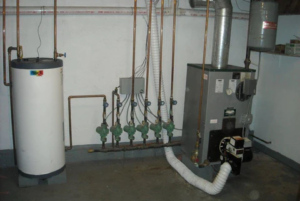Plumbing companies reduce potential water damage and other disasters to homes and businesses by conducting regular inspections. They also repair, install, and replace plumbing fixtures. Contact Ranger Plumbing Company for professional help.

A strong plumbing brand builds trust with clients and sets the company apart from competitors. It also helps establish the business as a professional, well-established organization.
Plumbing services are a necessary part of home and business maintenance, ensuring access to clean water and efficient waste disposal. A well-maintained plumbing system can also reduce the risk of waterborne illnesses and contribute to a sustainable environment. Whether you have a leaky faucet or clogged drain, a professional plumber can help.
Most plumbing companies offer a wide range of residential and commercial installation services. Their team of experts can handle everything from installing sinks and toilets in kitchens and bathrooms to repairing or replacing water heaters and pipes. They can also install venting systems to prevent sewer gases from entering living spaces.
A plumber’s job is a hands-on position that requires a lot of physical activity. They must be able to work on ladders and in tight spaces, and may need to carry heavy tools or equipment. They also need to be prepared for weather-related delays and traffic conditions. A plumber must have a good working knowledge of local codes and regulations.
Plumbing businesses can offer lucrative income streams if they are successful. They can generate revenue from recurring customer subscriptions, which can be an effective way to increase sales and boost profits. In addition, they can benefit from referrals, which are an excellent source of new customers. However, it is important to understand the potential risks of running a plumbing company before making the decision to invest.
When choosing a plumbing company, it’s essential to find one that provides quality work at a competitive price. Look for a company with years of experience and a reputation for excellent service. A good plumbing company will take the time to listen to its customers and offer solutions that are tailored to their needs.
Starting a plumbing business requires a substantial investment of both time and money. The initial investment can include the purchase of equipment and materials as well as training and certification costs. In addition, you will need to set up financial systems to track expenses and income. Lastly, you will need to determine your legal structure. Many plumbers choose to establish a sole proprietorship for simplicity, while others opt for an LLC to separate their personal and business assets. Regardless of the business model you select, it’s important to consult with a legal professional to ensure tax compliance and avoid liability issues.
Repair
A plumbing company can repair any issue you may have with your home’s water system. This includes clogged drains, broken toilets, and faulty faucets. Plumbing contractors can also install energy-efficient appliances, such as water heaters and low-flow fixtures, to help you save on your utility bills.
A plumber can also assist you with septic tank repair, sewer line cleaning and installation, and garbage disposal problems. They can even inspect your pipes for damage and corrosion. This is especially important since a damaged pipe can lead to flooding, water and mold damage, and costly repairs.
Most people think of plumbers as someone to call when there is a problem with their toilets or sinks. However, there are many other services that they offer that can benefit homeowners and businesses alike.
Plumbing services for homes can include everything from repairing leaky faucets to installing whole-home water filtration systems. A plumbing contractor can even take care of sewer line repair and replacement, as well as gas line installations and repairs. They can also inspect and maintain your water heater to ensure it is working safely and efficiently.
Leaks are one of the most common issues that plumbers deal with on a daily basis. They can be caused by a variety of factors, from a simple clog to a major ruptured pipe. Regardless of the cause, it is essential to have any leaks repaired as quickly as possible to minimize damage and avoid costly repairs down the road.
In addition to leaking pipes, plumbers can also deal with clogged drains and toilets, faulty garbage disposals, and rusty water fixtures. They can use visual aids like plumbing cameras or high-pressure water jetters to locate the source of a leak and then fix it accordingly. They can also install or replace water heaters, washers and dryers, and spigots.
Before you start your own plumbing company, it’s important to know the ins and outs of the business. It’s also a good idea to have a business plan in place with set goals and milestones for your company to keep you on track. You will also need to decide how you’ll structure your business, such as a sole proprietorship, limited liability corporation, or partnership. Each type of business has its own unique set of risks and liabilities, so it’s important to research each option thoroughly before making a decision.
Maintenance
Plumbing is one of the most important cornerstones of modern civilization. It provides access to clean drinking water and efficient waste disposal, protects against dangerous waterborne diseases, and ensures the smooth flow of sewage. However, problems with a plumbing system can occur from time to time. When these issues arise, it is crucial to contact a professional plumber.
The most common plumbing services offered by a company include maintenance, repairs, and replacements. These professionals are trained to inspect and repair the pipes, fixtures, and appliances that supply water or dispose of wastewater in a home or commercial building. Maintenance services help keep these systems in good working condition, preventing future problems such as leaks or clogs.
Another service that plumbing companies offer is installing and maintaining water-related fixtures, including faucets, showerheads, toilets, and other equipment. Fixtures are the tangible components of a plumbing system that customers see and use regularly, so they need regular care to maintain functionality and appearance. Plumbers also replace existing fixtures, such as sinks or toilets, ensuring they are properly fitted and installed for optimal performance.
Plumbing companies can also repair and replace sewer systems, water heaters, and other large appliances that are connected to the main water line. This work often requires a permit, so it is important to check with local authorities before starting any projects. In addition, these professionals can reroute water service lines when necessary to prevent flooding and property damage.
As with any business, it is crucial to set up proper financial systems to track income and expenses. Many plumbers choose to launch their businesses as a sole proprietorship, which allows for quick setup and easy liability protection. Other options for startup capital include seeking out investors or obtaining a small business loan. It is also advisable to purchase general liability insurance, which typically costs around $115 per month or $1,378 annually, and workers’ compensation coverage for employees who are injured on the job.
Before hiring employees, a plumbing company should develop interview questions that evaluate a candidate’s problem-solving skills, customer service mindset, and reliability. These should be tailored to the specific needs of the business and avoid any questions related to age, religion, or marital status.
Replacement
From burst pipes to water heater replacement, a plumbing company offers services for the full spectrum of residential and commercial needs. It can also offer emergency services for clogged drain lines or backed-up sewer systems.
Sewer issues are notorious for causing messy, time-consuming disasters. From clogged toilets to overflowing basements, they can disrupt your home or business and leave you with an expensive repair bill. But with 24/7 availability, fast response times, and comprehensive services like hydro jetting, a plumber can handle any sewer problem.
Hiring a plumbing team can be a big investment of both money and time, so it’s essential to find the right people for the job. Interview candidates using carefully crafted questions that assess their plumbing skills, customer service mindset, and reliability (avoid asking about age, religion, or marital status). Conduct hands-on tests and check references to ensure the quality of work your prospective employees deliver.
